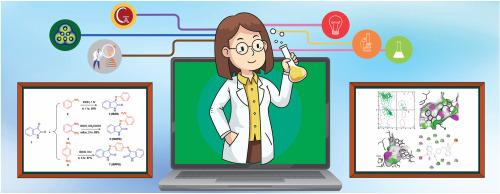Integrated DFT, topological, and ADME analysis of isatin-based Schiff bases: Synthesis and in silico antidiabetic evaluation
IF 3.4
4区 化学
Q2 CHEMISTRY, MULTIDISCIPLINARY
引用次数: 0
Abstract
This paper presents a comparative reactivity analysis of three isatin-derived Schiff bases for in silico antidiabetic applications. The synthetic accessibility of the isatin derivatives ISAN, ISOPD, and ISPPD was achieved through a wet-lab manner, followed by their characterisation using FT-IR, NMR, and HRMS analyses. The electronic environment, stability, and reactivity were comprehensively evaluated using geometry optimisation, FMO analysis, vibrational assignments, MEP plot, and NBO analysis based on DFT calculations. The reactivity profiling of the title compounds was validated through Fukui function analysis, grounded in conceptual DFT. Covalent and non-covalent interactions, including intramolecular hydrogen bond energies, were elucidated through topological analyses using ELF, LOL, RDG, and QTAIM methods. ADMET studies were conducted to determine the physicochemical properties of the title compounds. Subsequently, the potential of the isatin-appended molecules was evaluated computationally through molecular docking with two α-glucosidase enzymes, along with binding energy calculations. ISPPD exhibits higher binding energy than the reference compound acarbose, along with twice the number of active site interactions, highlighting its potential as a promising antidiabetic candidate.

isatin-based Schiff碱的综合DFT,拓扑和ADME分析:合成和硅抗糖尿病评价
本文介绍了三种isatin衍生的希夫碱在硅抗糖尿病应用中的比较反应性分析。ISAN, ISOPD和ISPPD的合成可及性通过湿实验室的方式实现,随后使用FT-IR, NMR和HRMS分析对其进行表征。通过几何优化、FMO分析、振动赋值、MEP图和基于DFT计算的NBO分析,对电子环境、稳定性和反应性进行了综合评估。通过基于概念DFT的Fukui函数分析验证了标题化合物的反应性分析。共价和非共价相互作用,包括分子内氢键能,通过拓扑分析,利用ELF, LOL, RDG和QTAIM方法进行了阐明。进行ADMET研究以确定标题化合物的物理化学性质。随后,通过与两种α-葡萄糖苷酶的分子对接,计算了isatin附加分子的势能,并计算了结合能。ISPPD表现出比参比化合物阿卡波糖更高的结合能,以及两倍的活性位点相互作用,突出了其作为有希望的抗糖尿病候选者的潜力。
本文章由计算机程序翻译,如有差异,请以英文原文为准。
求助全文
约1分钟内获得全文
求助全文
来源期刊
CiteScore
3.50
自引率
7.70%
发文量
492
审稿时长
3-8 weeks
期刊介绍:
The Journal of the Indian Chemical Society publishes original, fundamental, theorical, experimental research work of highest quality in all areas of chemistry, biochemistry, medicinal chemistry, electrochemistry, agrochemistry, chemical engineering and technology, food chemistry, environmental chemistry, etc.

 求助内容:
求助内容: 应助结果提醒方式:
应助结果提醒方式:


